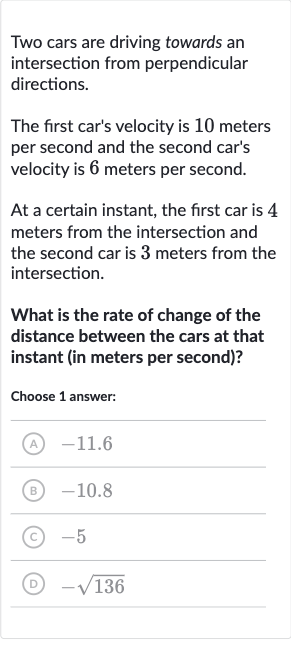AI tutor
Welcome to Bytelearn!
Let’s check out your problem:

Two cars are driving towards an intersection from perpendicular directions.The first car's velocity is meters per second and the second car's velocity is meters per second.At a certain instant, the first car is meters from the intersection and the second car is meters from the intersection.What is the rate of change of the distance between the cars at that instant (in meters per second)?Choose answer:(A) .(B) .(C) (D)
Full solution
Q. Two cars are driving towards an intersection from perpendicular directions.The first car's velocity is meters per second and the second car's velocity is meters per second.At a certain instant, the first car is meters from the intersection and the second car is meters from the intersection.What is the rate of change of the distance between the cars at that instant (in meters per second)?Choose answer:(A) .(B) .(C) (D)
- Formulating Right Triangle: The distance between the cars can be represented by the hypotenuse of a right triangle, with the sides being the distances of the cars from the intersection.
- Applying Pythagorean Theorem: Let's call the distance between the cars "d". Using the Pythagorean theorem, .
- Calculating Distance: Calculating , we get which is .
- Finding Rate of Change: Taking the square root of both sides, , so meters.
- Using Chain Rule: Now, we need to find the rate of change of with respect to time, which is .
- Differentiating Distances: Using the chain rule, , where and are the distances of the cars from the intersection.
- Determining Velocities: Differentiating with respect to and , we get rac{dd}{dx_1} = rac{4}{5} and rac{dd}{dx_2} = rac{3}{5}.
- Calculating Rate of Change: The rates and are the velocities of the cars, which are and , respectively (negative because they are approaching the intersection).
- Calculating Rate of Change: The rates and are the velocities of the cars, which are and , respectively (negative because they are approaching the intersection).Plugging in the values, .
- Calculating Rate of Change: The rates and are the velocities of the cars, which are and , respectively (negative because they are approaching the intersection).Plugging in the values, .Calculating , we get which is meters per second.
